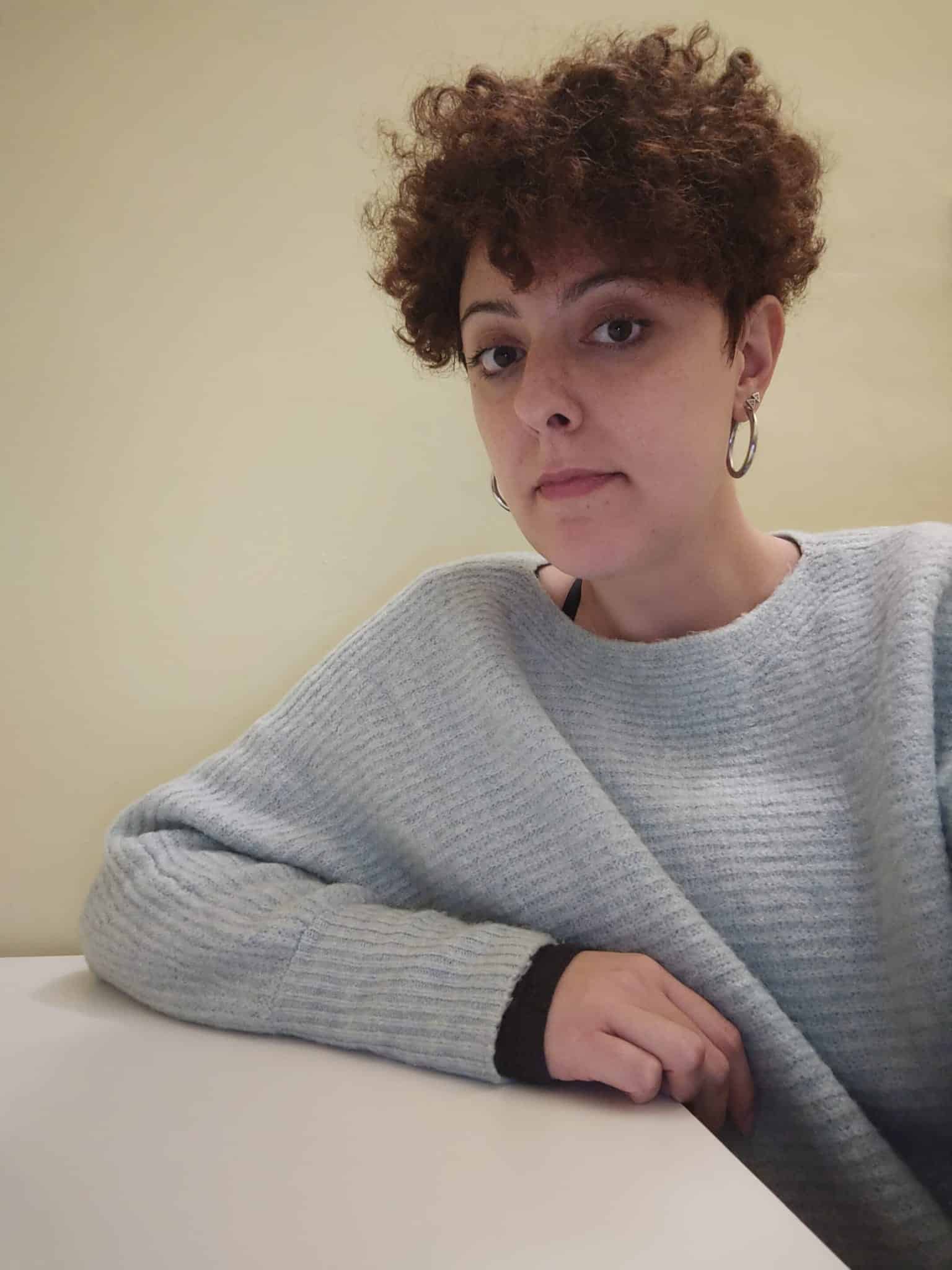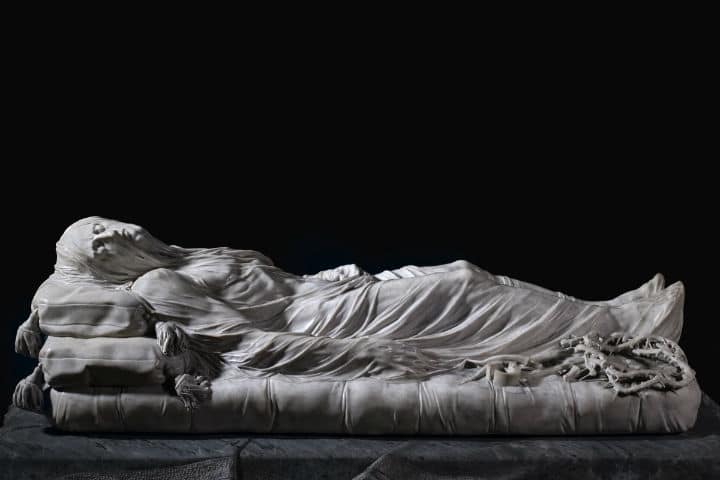Veiled Christ is one of the most important piece of art, from a cultural and artistic perspective, and it is kept within Cappella Sansevero.
It attracts the curiosity of lots of tourists, because the marble statue designed by Giuseppe Sanmartino is said to move and touch whoever admires it.
Cappella Sansevero, chest to this and other masterpieces, is located 700 metres from our rooms, about 8 minutes walk, taking Via Mezzocannone.
You will find yourself in the historical centre, the beating heart of Naples, ready to live an experience that you will remember forever.
This aristrocratic chapel contains treasures of the international and artistic heritage, besides Veiled Christ, and it is imbued with beauty and mystery.
Di cosa parliamo in questo articolo
Veiled Christ: the story of and artistic masterpiece
Sansevero prince, Raimondo di Sangro, commissioned a life-size statue of Jesus covered by a transparent shroud.
The work should have been designed by the sculptor Antonio Corradini, who died prematurely and left just a small terracotta draft, now kept at the Museum of San Martino.
The sculpture was carried out in 1753, by the Neapolitan artist Giuseppe Sanmartino, who managed to perform a work of rare beauty.
A life-size Jesus laying down on a bed, covered by the shroud, the head between to pillows; the crown of thorns and the spikes taken away from the cross at his feet.
The statue owns an evocative and touching power, but the marble veil is what makes it the artistic masterpiece well-known across the board and analysed by many art historians: it seems like soft fabric, highlighting each and every muscle of Christ.
Veiled Christ: legends
It has been exactly the marble veil and its mysterious creation to pave the way for a whole series of legends about the sculpture, the chapel and its eccentric owner, Sansevero prince.
Among the most narrated stories, the most famous one is certainly the legend according to which the prince, scientist and alchemist, had taught the artist Giuseppe Sanmartino how to marble a piece of cloth by means of an alchemical process.
This would mean that the veil is not marble, but the result of a calcification of the cloth in marble cystals.
Could it be true?
The legend has raised no little curiosity, so that it has even roused research about the art commission.
A payment receipt in favour of the artist for the making of the veil “to be made from marble and that will cover Our Lord” is kept within the Historical Archive of Banco di Napoli.
Although it is known that the veil is made of marble, the Veiled Christ statue is always able to instil some doubts because of the perfect creation and for the mystic atmosphere of the place.
Sansevero Chapel: opening times and tickets
The chapel is closed on Tuesday.
Here are the opening times:
9.30 a.m. – 6.30 p.m., the last entrance is allowed until 30 minutes before the closing.
Ticket price:
- Regular ticket: € 7.00;
- Artecard: € 5.00;
- from 10 to 25 years old: € 5.00;
- Schools: € 3.00;
- Children under the age of 10: free.
Sansevero Chapel: what to see beyond Veiled Christ
Sansevero Chapel represents its owner’s personality, the seventh prince of Sansevero, Raimondo di Sangro.
In an upsetting atmosphere of artistic beauty and mystery, this tiny place is a temple to priceless work of arts.
Within the same room, you can admire the 10 Statues of the Virtues: 9 represent women from Sansevero family, the 10th one – Il Disinganno – is dedicated to the father of the prince.
The statue depicts a man caught in a net, from which he tries to escape to meet the faith.
Indeed, prince Raimondo’s father had lived a very dissolute and licentious life, until he decided to retire to a convent, probably tormented by his sense of guilt and his fear.
As opposed to the statue of Disinganno, there is the one of Pudicizia, that is holding on a gravestone dedicated to the mother of the prince, who died when she was only 23.
Within the chapel, you can also see very peculiar works: the Anatomical Machines.
They are two stripped-to-the-bone, male and female, bodies, of which all the circulatory system is visible.
There is a legend even about them, fostered by the refusal of the current owners to let the machines be scientifically analysed.
It is said that they were two servants of the prince, employed for his alchemical experiments after their death.
Horrific, isn’t it?
Actually, there exists a document between Raimondo di Sangro and Salerno Doctor
about the making by the latter of two skeletons on which the cardiovascular system prepared by the prince alchemist had to be installed.
The veins and arteries that you can see in detail are made up of iron wires, coloured wax and… secret matters!
A touch of mystery: not all the secrets of prince Sansevero can be revealed!
The chapel contains the tomb of Raimondo di Sangro too: at first glance, it is very austere.
How come that such a bizarre and eccentric personality has such a composed mausoleum?
If you look carefully, it is rich in symbols that pay tribute to his scientific, military and literary capabilities.
Moreover, the eulogy on the marble sheet is made in relief, by means of a technique with chemical solvents, carried out by the prince himself.
The last piece of advice is to look up towards the vault of Sansevero Chapel, painted by Francesco Maria Russo. It shows the Gloria del Paradiso or Paradiso dei di Sangro.
The colours of the fresco are vivid, though 250 years have passed from its fulfilment and they have never been retouched, because it seems that the artist adopted a chemical formula of the prince to blend tempera.
And this is another mystery of Sansevero Prince!
We hope to have aroused your curiosity and inspired you to visit Sansevero Chapel and its Veiled Christ, so that now you want to come to Naples to see closely where reality begins and occult ends.

Insegnante di lingua e letteratura inglese per la scuola secondaria, traduttrice e correttrice di bozze. Coltivo con devozione e premura l’interesse per la cultura giapponese, e nutro tutte le mie altre creature con la stessa cura: libri, film, musica. Viaggio tanto, ma resto figlia di Partenope.

